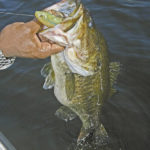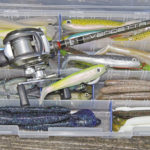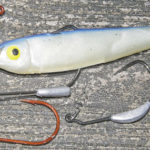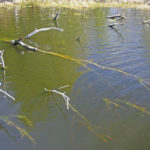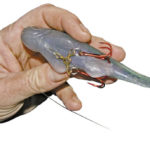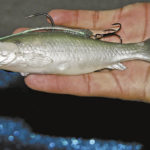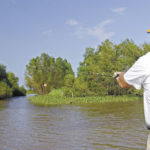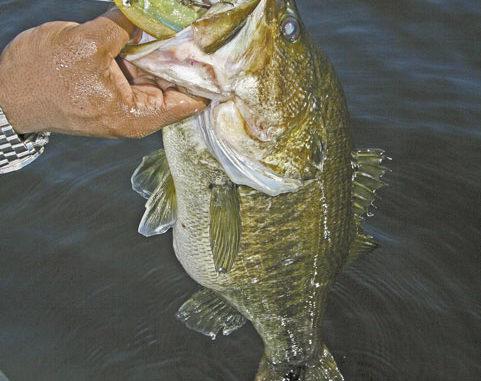
Swimbaits deliver Louisiana bass
About the only way to make a soft-body swimbait more user-friendly would be teaching it to tie its own knot. Short of that, just sling one out, wind it back and note how this hunk of molded plastic excels at doing the work for you.
Designed to wiggle their backsides just like a live baitfish, swimbaits display tantalizing motion with nothing more than a straight retrieve. Subtle rod work and varied retrieve cadences only serve to enhance the range of impersonation, but these highly-effective baits create loads of bass-attracting vibration on their own.
Baits with hollow spines like the Cabela’s FLATTIRE swimbaits or Mann’s 5½-inch Hard Nose SwimShad give solid baits optimal flexibility for incredibly lifelike action. Sebile takes the action a step farther with the Magic Swimmer Soft — a pliable version of the popular Magic Swimmer jointed swimbait. Sebile’s soft swimbait is designed with wedges cut into its flanks mid-body and at the tail. This results in one of the most realistic swimming motions available.
Generally shaped to resemble a forage fish of various flavor, a swimbait’s size — usually at least 4 inches — represents a large mouthful that appeals to big bass, while intimidating the smaller ones. Some, like the Berkley Havoc Grass Pig or Reaction Innovations Skinny Dipper, combine that traditional paddling swimbait tail with an elongated body.
Elsewhere, Wave’s 5-inch Tiki Snake and 7-inch Tiki Anaconda imitate the undulations of a swimming serpent. In any form, it’s the swimbait’s irresistible backside boogie that bass can’t resist.
Favoring a V&M Kickin Shad or Hightail Shad, Opelousas angler Jeremy Guidry said the soft-plastic swimbait’s biggest advantage over a hard bait of similar size and shape is its ability to fish in and around vegetation. Whereas a hard bait’s dangling treble hooks would grab grass on every cast, a soft swimbait slips through the salad with relative ease.
“I really like it in thick vegetation — you can run it over grass, or through heavy grass,” he said. “A lot of places where you would normally throw a Ribbit Frog or Horny Toad, the swimbait works the same way.”
The advantage, Guidry said, arises when a bass wants to eat a moving bait, but doesn’t want to dry his lips in the process. Hot days, clear water, high pressure — any of these factors may find the fish disinclined to topside appearances, so a subsurface presentation is the best approach.
“I’ve seen a lot of times when the fish don’t want to break the surface of the water,” he said. “A lot of times, they’ll blow up on a frog and they just won’t eat it, but when they get a hold of that swimbait, they’ll eat it better.”
We’ll get back to that shortly. First, let’s look at the rigging fundamentals.
Hook it up
Swimbaits can be made to swim throughout the water column, so you’ll appreciate how multiple rigs afford you the versatility to handle various scenarios. I heard a good testament to that premise in mid-May when the Walmart Bass Fishing League brought its All-American to Cross Lake. Tennessee angler Lloyd Pickett Jr. was fishing around the deeper cypress trees when a big opportunity found him ill-prepared.
“I heard a splash and saw this 5-pounder come up chasing shad right by my boat,” Pickett said. “I grabbed my swimbait, but I had it rigged for down and I should have (thrown) one that was rigged for up.”
As Pickett explained, he would have had a better chance of enticing the feeding bass with a swimbait that swam near the surface, as opposed to one that dropped deep for a bottom presentation. Day to day, you’re likely to find applications for both. Sunny conditions will push fish deeper, windy afternoons may find them chasing baitfish blown against shorelines. Cover your bases by keeping weighted and unweighted swimbaits handy.
For the weighted needs, some anglers like the all-inclusive simplicity of a swimbait with a built-in lead head like the Spoiler Shad by Crème Lure Co. Those who like to mix and match head size and tail colors will go with something like Revenge Swimbait Hedz or a Yamamoto Swimbait Jig and add the body of their preference.
The other option is a weighted hook — basically a standard swimbait hook plus lead. Sebile’s Soft Weight System enables anglers to add or remove lead cylinders to adjust the bait’s depth. Likewise, the Daiichi Buttdragger’s pinch-on weight grips the hook shank with pliable lead tabs. Remove the entire weight, or snip off segments of the weight as needed to affect the desired presentation depth.
With either of these systems, weight positioning influences the bait’s orientation on the fall. Move the weight forward, and the bait descends head-first. Slide it back, and the bait falls level. Experiment with the weight amount and positioning to determine the precise arrangement that suits your plan. (Test each configuration by dropping the bait at boatside and watching it fall. If you have a swimming pool, you can dial this in before leaving for the lake.)
Guidry is not averse to a weighted hook, but in heavy vegetation, he’ll use a 1/32- to 1/8-ounce bullet weight to sink his swimbait because the front-end accessory guards the bait’s nose. Fish demeanor, Guidry said, determines his weight size. When warmer water has the fish more active, he’ll work the bait faster with a heavier weight. If the fish are sluggish in cold or hot conditions, he’ll slow down and rig a lighter bullet weight.
An essential element of swimbait hooks, weightless or weighted, is a mechanism for securing the hook to the bait without running a hook through its body, as with Texas rigging. From the Daiichi Hitchhiker to Gamakatsu’s Spring-Lock to Owner’s TwistLOCK Centering-Pin Spring, a piece of thin wire that stabs and/or coils into the bait’s head about a quarter inch holds the plastic in perfect alignment. Simply run the point into the belly and out the back so it sits in a weedless position.
Rigging tip: Swimbaits with weighted heads and exposed hooks will only frustrate you around vegetation or heavy cover, so go with a through-body hook — weighted or unweighted, depending on the scenario. Most swimbait hooks are designed so the point lies flat against the bait’s back for a weedless presentation. Occasionally, though, points can shift during use and allow room for debris to catch between the metal and the plastic. The simple fix: pin the hook point into the bait’s back just enough to prevent separation. To avoid missing hook sets, keep the insertion shallow enough for the point to easily break free on a strike.
For a more proactive approach, prevent weed snagging by ensuring proper hook placement. When you run the hook through the bait’s belly and out the back, bringing the point out too far forward gives the bait excessive room to slip down the hook’s bend, and that opens a gap between the back and the hook point. Essentially, you want the bait snug against the top side of the hook bend so the plastic’s own tension holds it in place.
Don’t overdo it, though. Inserting the hook point too far back on the bait creates an unnatural bend by bunching the bait in front of the hook bend. Sebile simplifies the procedure with a hook channel drilled through each bait. When in doubt, use the pinch method: Lay the hook level with your bait, lightly pinch the body where the bottom of the bend aligns and use this point as your guide for running the hook through the bait.
When and where
Unquestionably, one of the best times to throw a swimbait is the postspawn period when big females return shallow to rebuild their bulk by gobbling the bream that’ll be bedding near the shore. These bass want hefty meals, so they’re unlikely to pass.
“Postspawn is probably my favorite time for soft-plastic swimbaits,” Guidry said. “A lot of times, I’ll try to match the bream color. I’ll go with a watermelon or green pumpkin bait and dye the tail chartreuse.”
Backing up a little, the swimbait is also a strategic tool for bedding bass. Think about it — big mama has committed to a nice little fanned-out nursery and all she wants is some peace and quiet while she squeezes out the next generation. Suddenly, some jack wagon comes galloping right overhead. There he goes again. Wait, now this fool’s gonna run right across the nest.
True, some fish will spook and run, but let that swimbait cross the radar of a big, irritable female who’s just about over this pregnancy thing, and the meeting will take a violent turn.
Florida bass pro Michael Bennett — a transplant from swimbait-crazed California — said the big, bold baits pose a significant threat and spur the lady of the house into action. The basic premise: Create a situation in which the big fish has to step in for a male that is too intimidated to attack.
“A lot of times the males aren’t going to want to challenge that bigger (bait) and the females come up and take over,” Bennett said.
Returning to the vegetation scenario, Guidry offers this insight: “Sometimes, I will buzz my swimbait across the thick grass and let it drop down into the holes. I find that they’ll commit to the swimbait a lot more than the frog. Sometimes, they’re really aggressive and they’ll hit it on top, but normally, I run it from 6 inches to a foot-and-a-half deep.”
Swimbaits also work great around docks, boat houses and marina walkways — especially during a shad spawn. You’ll also want to run one of these wiggling baits along the trunk of a big laydown, past bridge pilings and through the mouths of spillways. When fish hold deep, slow hopping a swimbait along the bottom in classic tube fashion can rattle up a bite.
Now, just because swimbaits are designed to swim doesn’t mean the options end there. Consider this: Shad, bream and other forage fish spend plenty of time suspending and nosing down to feed. Simulating such postures with a bait that bass rarely see in these positions can trigger strikes you may not otherwise get. To this end, try using swimbaits for targeted presentations on Texas rigs or dropshots.
For a suspended presentation near the bottom, Guidry rigs a swimbait with a weightless hook on a Carolina rig. And when he throws a swim jig, guess what’s on the back end? With any of these alternative presentations, you may entice an opportunistic bass with your bait falling or in a stationary position, but expect the aggression bites when you move the rig and that tail starts kicking.
